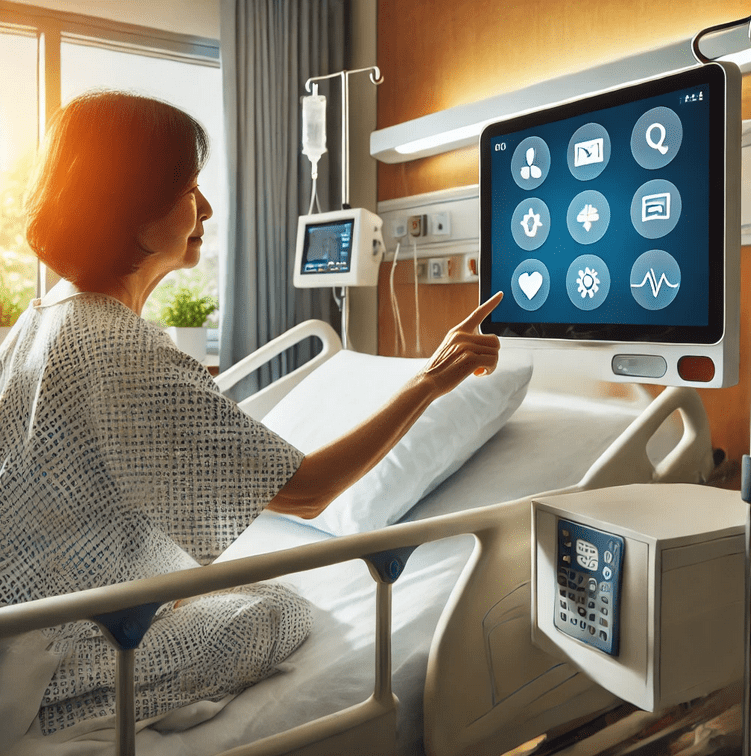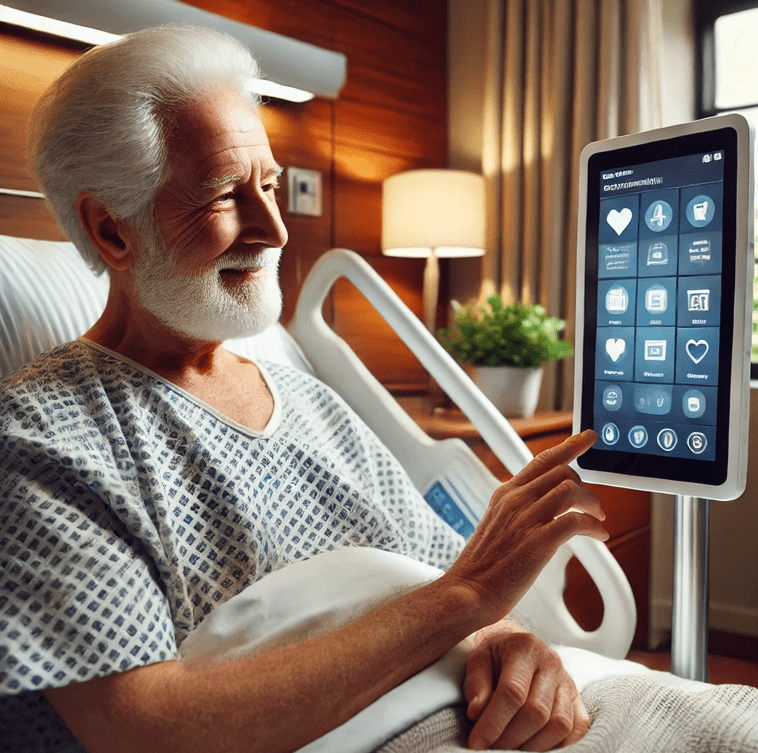Integrated Bedside Terminals (IBTs) represent a remarkable innovation in healthcare, seamlessly blending patient care, entertainment, and streamlined operations within a single device. They not only enhance the patient experience but also support healthcare providers in delivering quality care efficiently.
This article will delve into what IBTs are, their core functionalities, the benefits they bring to healthcare, the technologies driving them, and the considerations for implementing these systems in healthcare settings.

What Are Integrated Bedside Terminals?
Integrated Bedside Terminals are touchscreen devices installed at a patient’s bedside, offering a wide range of functionalities including entertainment, health monitoring, and communication. They serve as a direct interface between patients and healthcare providers, enabling a more interactive and patient-centric approach to healthcare.
Depending on the configuration, these terminals can support medical documentation, electronic health records (EHR) access, remote monitoring, and a host of other patient services.
Core Functionalities of Integrated Bedside Terminals
IBTs can vary in capability based on healthcare facility needs, but generally, they provide:
- Patient Information and Education:
- Access to personal medical information, including lab results, upcoming treatments, and health education resources.
- Educational videos on managing health conditions or understanding procedures to help patients be more informed participants in their care.
- Entertainment and Connectivity:
- Television, internet access, video calling, and even access to social media platforms to help patients stay connected with loved ones and maintain a positive mental state.
- Direct Communication with Healthcare Staff:
- Patients can directly message or call nurses or other medical staff, improving communication and response times.
- Real-time translation services to bridge language gaps between patients and caregivers.
- Clinical Support for Healthcare Providers:
- Secure access to electronic health records, enabling doctors and nurses to input and retrieve patient data quickly.
- Digital tools for medication administration, monitoring, and care management to reduce administrative burden and enhance efficiency.
- Control of Room Environment:
- Patient control over room lighting, temperature, and bed positioning, which can improve comfort without requiring staff assistance for each adjustment.
- Monitoring and Telehealth Integration:
- Integration with telehealth services allows for remote consultations and quick access to specialists.
- Vital sign monitoring and early warning systems alert healthcare providers to potential issues, promoting early intervention.
Benefits of Integrated Bedside Terminals
- Enhanced Patient Experience:
- By providing entertainment and communication options, patients feel more at ease, which can improve overall satisfaction and reduce anxiety related to hospital stays.
- Improved Clinical Workflow Efficiency:
- Automating certain tasks, such as recording patient data or providing self-service options, enables healthcare providers to focus more on critical aspects of patient care.
- Doctors and nurses have immediate access to essential patient information, enhancing decision-making accuracy and speed.
- Real-Time Data Access:
- Physicians and nursing staff can access real-time data on patients’ vitals, historical data, and treatment plans, streamlining the care process.
- Increased Patient Engagement:
- Educating patients about their health conditions and treatments fosters greater engagement and can lead to better outcomes.
- Patients can actively participate in their healthcare, asking questions and managing their environment, which may lead to faster recovery times.
- Enhanced Infection Control:
- Minimizing the need for physical paperwork and other shared items can help prevent the spread of infections in healthcare settings.
Technologies Behind Integrated Bedside Terminals

- Touchscreen and Interactive Display Technology:
- User-friendly and intuitive touch interfaces ensure that all age groups and tech-savvy levels can easily navigate the system.
- Cloud Computing and Data Integration:
- Cloud integration enables real-time data sharing, ensuring healthcare providers have up-to-date information while enhancing data security.
- IoT and Telehealth Connectivity:
- Internet of Things (IoT) technology allows integration with devices that monitor patient vitals, enabling continuous health tracking and remote monitoring.
- Machine Learning and Predictive Analytics:
- Leveraging analytics allows for personalized care recommendations and alerts to clinical staff when patients show signs of deterioration.
- Cybersecurity Measures:
- Advanced cybersecurity protocols protect sensitive patient data, complying with healthcare regulations like HIPAA and GDPR.
Considerations for Implementing Integrated Bedside Terminals
- Cost and Budgeting:
- The initial investment can be significant, involving the cost of hardware, software licenses, and ongoing maintenance. Budgeting for these systems may require reallocating funds from other areas or seeking grants.
- Interoperability with Existing Systems:
- IBTs must seamlessly integrate with the hospital’s existing EHR and patient management systems to avoid workflow disruptions.
- Training for Healthcare Staff and Patients:
- Healthcare providers and support staff need training to utilize IBTs effectively, and user-friendly tutorials can help patients understand the functions available to them.
- Cybersecurity and Data Privacy:
- Protecting patient data is a top priority, and healthcare facilities must implement strict security measures, such as encrypted data transmission and secure login protocols.
- Scalability and Customization:
- Systems should be scalable to accommodate future advancements, such as AI-assisted diagnosis or additional telehealth functionalities, and customizable to meet specific needs of the hospital or patient demographic.
Future of Integrated Bedside Terminals
As technology continues to evolve, the role of Integrated Bedside Terminals in healthcare is likely to expand. Future advancements may include AI-based predictive analytics that proactively alert healthcare providers to potential complications, improved telemedicine capabilities that allow for specialist consultations, and voice-activated systems for even easier use by patients with limited mobility.
Integrating augmented reality (AR) and virtual reality (VR) elements could further enhance patient education and training, offering interactive experiences that aid in understanding complex health issues.

No comments yet